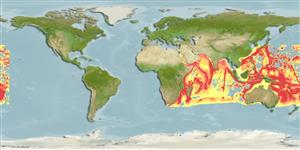>
Blenniiformes (Blennies) >
Blenniidae (Combtooth blennies) > Blenniinae
Etymology: Xiphasia: Greek, xiphos = sword (Ref. 45335).
Eponymy: Dr Kiyomatsu Matsubara (1907–1968) was originally called Kiyomatsu Sakamoto but on marrying he took his wife’s name as the family surname. [...] (Ref. 128868), visit book page.
Environment: milieu / climate zone / depth range / distribution range
Ecologia
marino benthopelagico; distribuzione batimetrica 0 - 4960 m (Ref. 40919). Deep-water; 32°N - 35°S, 18°E - 169°W
Indo-Pacific: Red Sea to Samoa and Ellice Islands, north to Japan, south to Lord Howe Island; Mariana Islands in Micronesia. Southeast Atlantic: False Bay, South Africa (Ref. 4404).
Size / Peso / Age
Maturity: Lm ? range ? - ? cm
Max length : 30.0 cm SL maschio/sesso non determinato; (Ref. 1602)
Short description
Chiavi di identificazione | Morfologia | Morfometria
Spine dorsali (totale) : 11; Raggi dorsali molli (totale) : 99 - 104; Spine anali: 2; Raggi anali molli: 97 - 104.
Adults inhabit deep waters but rises to the surface at night. Rare species (Ref. 559). They live in tubes in fine sand or mud and rise to the surface at night where they fall prey to pelagic fishes (Ref. 37816). Oviparous. Eggs are demersal and adhesive (Ref. 205), and are attached to the substrate via a filamentous, adhesive pad or pedestal (Ref. 94114). Larvae are planktonic, often found in shallow, coastal waters (Ref. 94114).
Life cycle and mating behavior
Maturità | Riproduzione | Deposizione | Uova | Fecundity | Larve
Oviparous, distinct pairing (Ref. 205).
Myers, R.F., 1991. Micronesian reef fishes. Second Ed. Coral Graphics, Barrigada, Guam. 298 p. (Ref. 1602)
IUCN Red List Status (Ref. 130435: Version 2024-1)
Threat to humans
Harmless
Human uses
Strumenti
Special reports
Download XML
Fonti Internet
Estimates based on models
Preferred temperature (Ref.
123201): 2.4 - 6.8, mean 3.5 °C (based on 2061 cells).
Phylogenetic diversity index (Ref.
82804): PD
50 = 0.7500 [Uniqueness, from 0.5 = low to 2.0 = high].
Bayesian length-weight: a=0.00102 (0.00046 - 0.00225), b=3.06 (2.88 - 3.24), in cm total length, based on all LWR estimates for this body shape (Ref.
93245).
Trophic level (Ref.
69278): 4.2 ±0.73 se; based on food items.
Resilienza (Ref.
120179): Medio, tempo minimo di raddoppiamento della popolazione 1.4 - 4.4 anni (Assuming tm=1-4 and Fec=100-1000).
Fishing Vulnerability (Ref.
59153): Low to moderate vulnerability (27 of 100).
